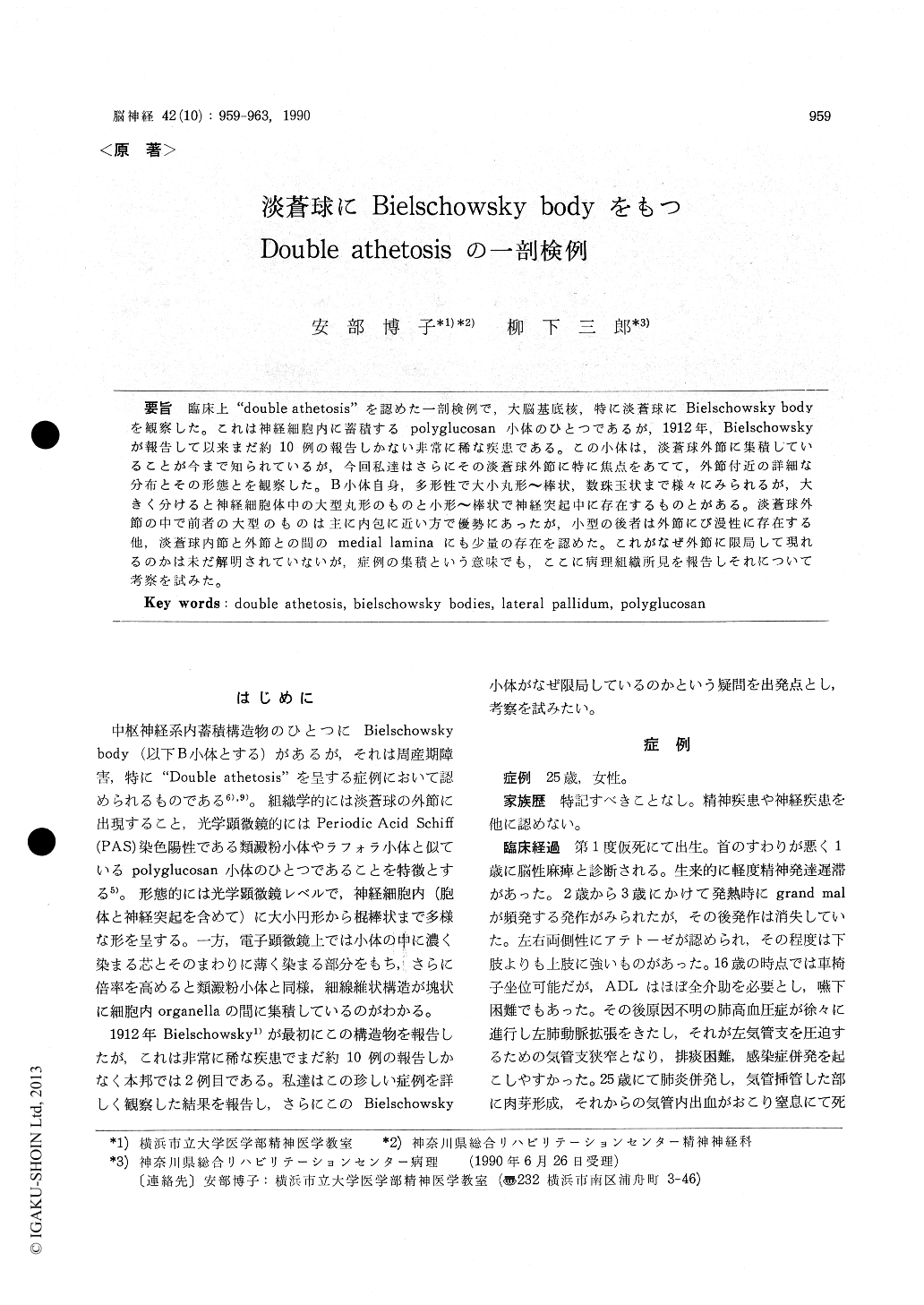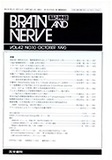Japanese
English
- 有料閲覧
- Abstract 文献概要
- 1ページ目 Look Inside
臨床上"double athetosis"を認めた一剖検例で,大脳基底核,特に淡蒼球にBielschowsky bodyを観察した。これは神経細胞内に蓄積するpolyglucosan小体のひとつであるが,1912年,Bielschowskyが報告して以来まだ約10例の報告しかない非常に稀な疾患である。この小体は,淡蒼球外節に集積していることが今まで知られているが,今回私達はさらにその淡蒼球外節に特に焦点をあてて,外節付近の詳細な分布とその形態とを観察した。B小体自身,多形性で大小丸形〜棒状,数珠玉状まで様々にみられるが,大きく分けると神経細胞体中の大型丸形のものと小形〜棒状で神経突起中に存在するものとがある。淡蒼球外節の中で前者の大型のものは主に内包に近い方で優勢にあったが,小型の後者は外節にび漫性に存在する他,淡蒼球内節と外節との間のmedial laminaにも少量の存在を認めた。これがなぜ外節に限局して現れるのかは未だ解明されていないが,症例の集積という意味でも,ここに病理組織所見を報告しそれについて考察を試みた。
This report analyzes a rare case of double athe-tosis with Bielschowsky bodies. These bodies are pleomorphic intra-neuronal PAS positive deposits mainly found in the lateral pallidums of both sides.
Clinically the patient was diagnosised as "double athetosis" and mild mental retardation. In her childhood she went through seizure attacks several times. The degree of athetosis was more severe in the upper extrimities than in the lower ones. At the age of 25 she died from suffocation.
Post-mortem findings : The brain weighed 1520 g. The cerebral cortex and cerebellum were not atrophic and externally not remarkable. Micros-copically the most remarkable finding was PAS positive intra neuronal inclusions mainly restricted to the lateral pallidum, which are known as "Bielschowsky bodies." They varied in size and shape, and divided into 2 types according to theirstructual features. One is rather round type most-ly in the intra-neuronal perikarya, and the other is small round but sometimes sausage-like in shape which is thought to be intra-axonal. We investi-gated the distribution of these deposits in and around the lateral pallidum. The distribution was different between these 2 types, that is, small and intra-axonal inclusions were seen "diffuse" all over the lateral pallidum and a little were in medial lamina which lies between lateral and medial pal-lidum, while large intra-perikaryal type were strictly restricted in the lateral pallidum and do-minantly found near the internal capsule. This patient experienced generalized convulsion several times in her childhood but severe ischemic change was not seen in cerebral structures, especially in the hippocampus. Electron microscopically these bodies consisted of the accumulation of irregular fine fibrils.
As mentioned before, these Bielschowsky bodies are one of the polyglucosan bodies. Such kind ofbodies are easily influenced by glucose metabolism in the brain. Therefore, these deposits indicated the existence of disturbance on glucose-glycogen metabolic cycle and would be built for a long period under mild dysmetabolic circumstances in locus. From the pathological findings almost all deposits follow the shape of axon or neuronal bodies and do not damage neurons themselves.
Other interesting finding is its dominancy of large-inclusion-type bodies in the lateral pallidum. They were tend to be found near the internal capsule. This could be related with her severity of athe-tosis in the upper extrimities, and reflect the fu-nctional disturbance of lateral pallidum.
This case was thought to have double athetosis suffered from birth injury. Patho-histological di-scussion is focused on the etiopathogenesis of Bie-Ischowsky bodies. Though the nature of the bo-dies remains still unsettled, this kind of data needs accumulating for the future.

Copyright © 1990, Igaku-Shoin Ltd. All rights reserved.


